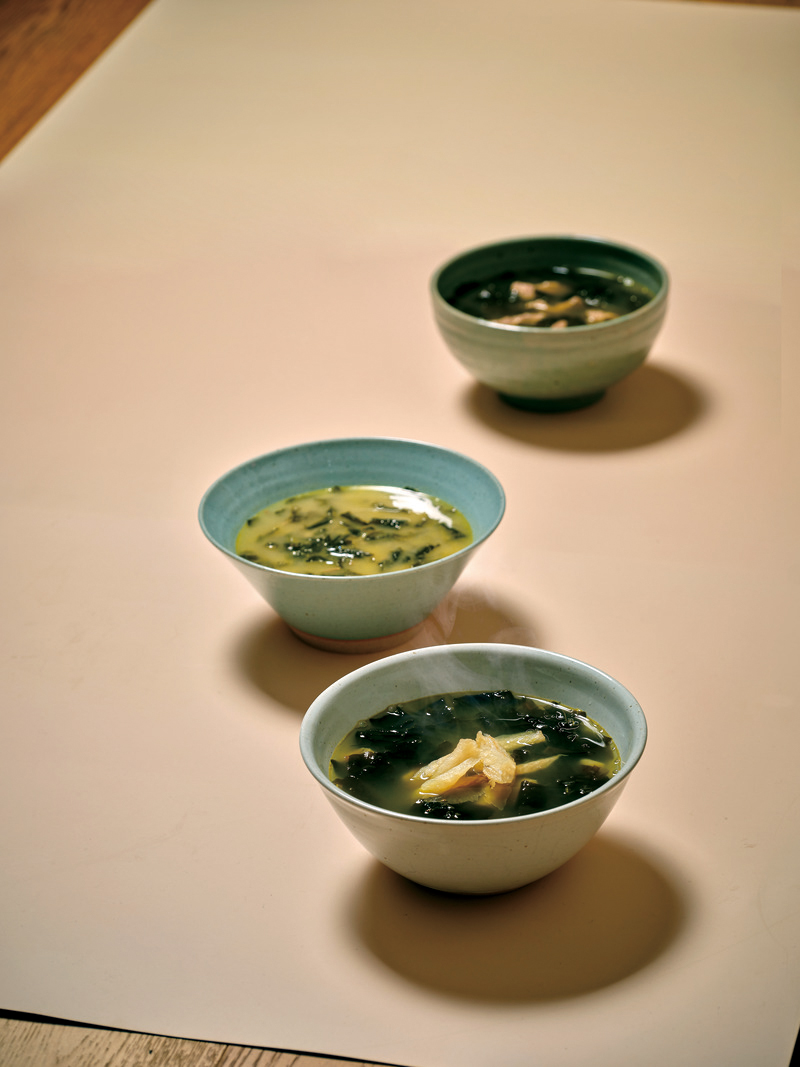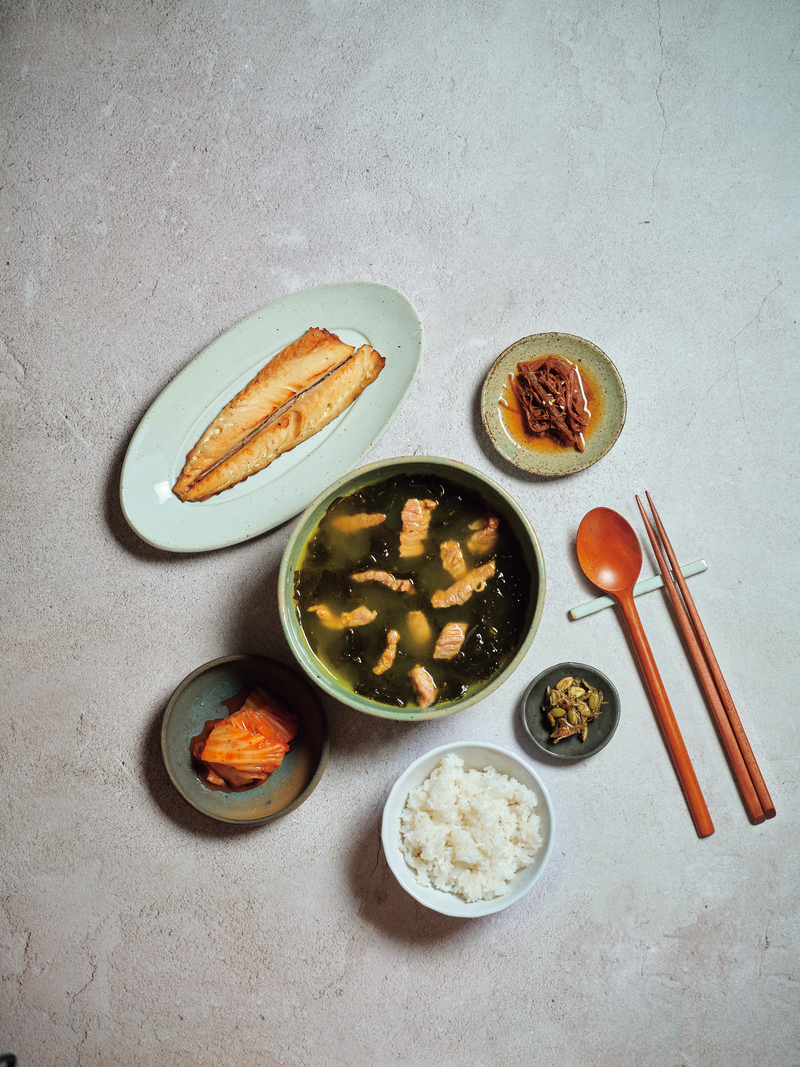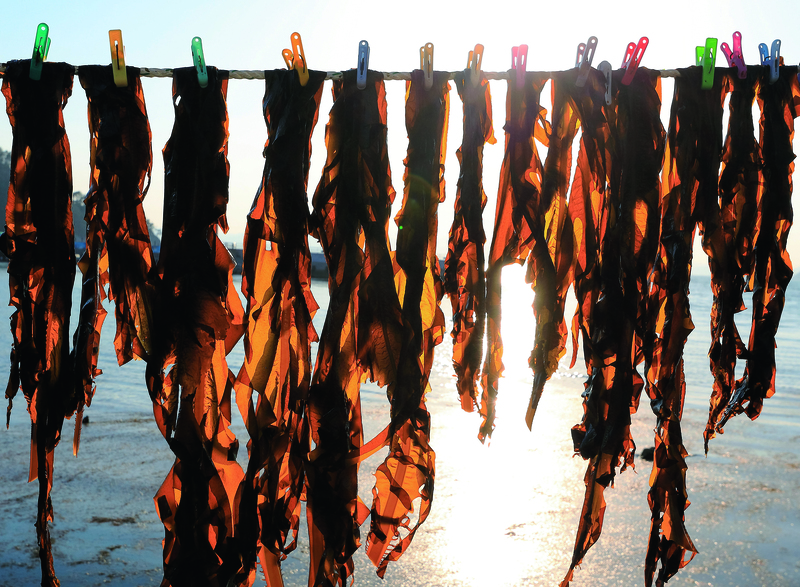미역과 간장, 참기름을 메인 식재료로 끓이는 미역국은 싱싱한 미역이 주는 식감과 구수하면서도 감칠맛이 있는 국물이 만나 바다의 풍미를 자아낸다. 미역국은 오직 한국에만 존재하는, 태생부터 한국요리라는 점에서도 주목할 만하다.
Miyeokguk, a soup primarily made with seaweed, soy sauce, and sesame oil, has a unique texture along with a savory taste that perfectly captures the essence of the sea. The dish is unique to Korea’s cuisine and a product of the country’s rich culinary tradition.

한국에서 음식의 맛을 표현할 때 짭짤하다는 말은 대부분 맛깔스러운 감칠맛을 설명할 때 쓴다. 짠맛의 정도가 지나치지도, 모자라지도 않은 적절한 수준을 잘 맞췄을 때 한국 음식은 감칠맛이 폭발하기 때문이다. 이처럼 적절한 짠맛을 완성하는 것이 중요한 한국의 국물 요리 중 하나가 바로 미역국이다.
In Korean, the term jjapjjalhada is often used to describe ingredients and dishes that are both savory and intensely flavorful. It also implies that the food is neither too salty nor too bland but has the perfect level required to elevate the overall taste. Achieving this delicate equilibrium is of great importance in Korean cuisine, particularly in dishes such as miyeokguk.
친근하고 특별한 음식 – SPECIAL YET COMFORTING
한국인에게 미역국은 친근하고 다정한 음식이다. 메인 식사로, 때로는 술안주나 다이어트식으로도 즐겨 먹는 대중 음식이기도 하지만, 미역국이 친근하고 특별한 이유는 따로 있다. Miyeokguk holds a special place in the hearts of many Koreans. While the soup is commonly served as the centerpiece of a meal, enjoyed as a side dish with drinks, or even eaten to help with weight loss, understanding what makes it so precious in the eyes of an entire nation requires a closer look.
한국에서는 산모가 출산하면 식사로 미역국을 챙겼다. 왜 하필 미역국이었을까? 미역은 단백질과 당질, 섬유질, 칼슘, 비타민 A, 칼륨, 셀레늄 등을 비롯해 다양한 비타민과 미네랄 성분을 포함하고 있다. 특히 미역의 철분과 요오드 성분은 몸속 혈액의 원활한 흐름을 돕고 높은 철분 함유량으로 빈혈 예방에 탁월하다. 이 때문에 오래전부터 산모가 출산하면 반드시 챙겨 먹어야 하는 음식으로 통했다.
It has long been customary for Korean women to eat miyeokguk in the days after giving birth. But of all the diverse dishes in Korean cuisine, why seaweed soup? The chief ingredient, namely seaweed, is rich in protein, carbohydrates, fiber, calcium, vitamin A, potassium, and selenium, as well as other vitamins and minerals. Its high iron and iodine content is especially beneficial for promoting blood circulation and preventing anemia, making it the perfect food for women who have recently given birth.
이것이 시초가 되어 한국 사람들을 생일이 되면 태어난 날을 기념하며 미역국을 끓여 먹는다. 생일날 온 가족이 모여 미역국을 나누어 먹으며 생일을 축하하는 것이 한국의 풍습이기도 하다. 반대로 미역국 먹기를 꺼리는 날도 있다. 시험을 보는 날과 면접을 보는 날이다. 시험이나 면접에서 떨어졌다는 뜻으로 쓰이는‘미역국 먹다’라는 말이 국어사전에도 있을 정도로, 이 두 날에 미역국을 먹으면 미끈거리는 미역국 때문에 미끄러져 넘어지거나 떨어진다는 속설이 있기 때문이다.
In line with this tradition, it has become common practice for families to gather on birthdays to enjoy a bowl of miyeokguk together as a way of commemorating the occasion. Conversely, there are times when Koreans intentionally avoid eating miyeokguk altogether, such as on the day of an exam or job interview. There is even a dictionary-listed Korean idiom, miyeokguk mokda, which translates to “eating miyeokguk,” and expresses the notion of failing an exam or interview. The meaning is rooted in a superstition that consuming the soup on such a day could cause a slip-up due to the seaweed’s slippery texture.
간단한 조리법 – A SIMPLE RECIPE
미역국의 레시피는 비교적 간단한 편이다. 재료는 마른미역과 소고기, 조선간장, 참기름, 그리고 소금 정도만 있으면 된다. 마른미역은 물에 넣고 충분히 불린 다음 물기를 짜고 4~5cm의 길이로 자른다. 소고기는 메인 재료라기보다 고소한 풍미를 살려주는 토핑 개념으로, 가로세로 1~2cm 크기로 작게 자른다. 냄비에 참기름을 두른 후 준비한 소고기와 미역을 넣어 겉면이 익을 때까지 볶는다. 이때 미역과 소고기에서 나오는 감칠맛이 고소한 참기름과 어우러지면서 맛깔스러운 향을 뿜어낸다. 뽀얀 국물이 우러나면 여기에 물을 추가로 넣은 다음 조선간장과 소금으로 간을 맞추고 30분 이상 끓여주면 완성이다. 물은 생수를 넣어도 되지만 더욱 진한 맛을 내려면 멸치로 우려낸 육수나 쌀뜨물, 또는 사골국물(소뼈를 장시간 우려 만든 국물로 묵직하고 구수한 맛이 일품이다)을 넣으면 된다. 미역국에 다진 마늘을 조금 넣으면 풍미가 더 살아나는데 미역과 소고기 본연의 맛에 집중하고 싶다면 생략해도 좋다.
The recipe for miyeokguk is relatively simple and only requires a handful of ingredients — dried seaweed, beef, sesame oil, salt, and gukganjang, a light soy sauce that’s an essential ingredient for Korean soups. First, the dried seaweed is soaked in water and allowed to expand, after which it is drained and cut into slices roughly four or five centimeters in length. The beef, which serves as a flavor enhancer rather than as the main ingredient, is cut into thin pieces of one or two centimeters.
After these steps have been completed, sesame oil is heated in a pot, in which the beef and seaweed are stir-fried until they are evenly cooked. This process generates a cloudy broth with a delightful aroma and also imparts the seaweed and beef with a nutty and savory flavor.
Once the broth starts to bubble, water is added. The soup is then seasoned with both salt and light soy sauce and left to simmer for another thirty minutes until the dish is ready to serve. Although plain water can be used, substituting it for anchovy stock, beef broth, or the starchy water left over from rinsing rice give the soup more depth and a richer taste. A small amount of minced garlic can also be added for extra flavor, but this step is usually omitted by those who wish to fully appreciate the underlying taste of the seaweed and beef.

오래 끓일수록 깊어지는 맛 – THE SECRET TO A DEEPER FLAVOR
미역 특유의 오독오독하면서도 미끌미끌한 식감과 짭짤한 국물, 고소한 소고기와 만나면 그 감칠맛이 배가된다. 미역은 해초의 일종인데 바닷속에 살면서 바다 향을 가득 품고 있기 때문에 그냥 먹으면 바다의 짠맛과 비릿한 맛이 강하게 난다. 그러나 깨끗하게 씻은 후 물에 불리는 과정을 통해 짠맛이 어느 정도 씻겨 내려가 은은한 바다의 맛과 향만 남는다. 미역을 소고기와 함께 참기름에 볶고 또 물에 끓이는 동안 각 재료의 맛이 우러나기 때문에 미역국은 오래 끓이면 끓일수록 감칠맛이 더욱 살아난다. 끓인 후 바로 먹을 때보다 두 번째, 세 번째 먹을 때 훨씬 더 맛있게 느껴지는 것도 이 때문이다.
Thanks to its distinctively crunchy and smooth texture, the incorporation of seaweed, along with pieces of flavorful beef, significantly elevates the soup’s taste profile. The seaweed used in the soup is sea mustard, a kelp species native to cold-temperate coastal waters. It possesses a notably salty and fishy taste when eaten raw. However, much of this saltiness can be reduced by thoroughly rinsing and soaking it in water, which leaves behind a far subtler flavor along with a pleasant aroma reminiscent of the ocean.
Stir-frying sea mustard with beef in sesame oil and then simmering them in water helps bring out the flavor in each of the individual ingredients. Hence, the longer miyeokguk is left to simmer, the more savory its flavor becomes. This is why it seems to taste even better when reheated.
뜨끈한 미역국에 달게 지은 흰 쌀밥을 말아 맛있게 담가 푹 익힌 김치를 올려 먹으면 그 자체로 한 끼 보약이 된다. 뜨겁고 묵직한 감칠맛은 한국인이 가장 좋아하면서 또 가장 익숙한 맛이다.
For a nourishing and satisfying meal, nothing beats a steaming portion of miyeokguk paired with a bowl of freshly cooked white rice and served with some well-fermented kimchi. This hot, hearty, and intensely savory soup boasts all the qualities Koreans look for in a dish.
미역국처럼 미역이 메인 재료가 되는 국물 요리는 한국에만 있는 전통음식이다. 다른 나라에선 구경조차 어렵다. 간혹 일본에서 미소된장국에 미역을 넣는 경우도 있긴 하지만 매우 소량인 데다 어디까지나 된장이 메인이지, 미역이 주인공인 메뉴는 아니다. 그렇기에 한국의 미역국은 외국에선 다소 생소한 음식으로 통한다. 서울 종로구에서 한식 레스토랑 두레유를 운영 중인 토니 유 셰프는 이탈리아 유학 시절 친구들을 집으로 초대해 미역국을 끓여준 적이 있다고 한다. 당시 해외 각국의 유학생들 모두 미역국을 보곤 “이 시커멓고 미끄덩거리는 이상한 물체는 무엇이냐?”라며 질색을 했다고 한다. 그러나 한 번 맛을 본 후로는 “앙코르 미역국”을 요청했다. 그들에게 미역국은 생소하지만 먹으면 먹을수록 중독성 있는 맛있는 미역 스튜였던 것이다.
With sea mustard as its main ingredient, miyeokguk is a uniquely Korean dish. Indeed, the incorporation of seaweed in soups is uncommon in most other cuisines. Miyeokguk thus remains a somewhat unknown dish abroad. Tony Yoo, the chef-owner of Dooreyoo, a Korean restaurant located in Seoul’s Jongno District, recalls preparing miyeokguk for some friends when he was studying in Italy. Upon seeing the dish, the reaction of his friends, who hailed from all corners of the globe, was particularly memorable. “What’s that dark, slimy, strange-looking thing?” one of them even asked in horror. After tasting the soup, however, everyone asked for seconds, affectionately dubbing the dish “encore miyeokguk.” Although Tony’s friends were initially skeptical because they had never tried the dish, they quickly found it to be deliciously addictive.

지역별로 특색 있는 미역국 – REGIONAL VARIATIONS
한국의 국물 요리는 그 종류가 무엇이 됐든 대체로 지역마다, 가정마다 먹는 형태나 들어가는 재료가 조금씩 다르다. 이는 지역별 특산물이 다르고 집마다 즐겨 먹는 재료 또한 차이가 있기 때문이다.
Korean soups tend to vary slightly between regions and households, from their preparation all the way to their individual ingredients. This can be attributed to the differences in local specialties as well as the respective cooks’ personal preferences.
미역국의 가장 기본적인 형태는 미역과 소고기를 넣는 것이지만 소고기 대신 바지락이나 동죽, 홍합과 같은 조개류를 넣기도 하고 가자미나 꽁치, 갈치 등의 생선 종류를 넣기도 한다. 그야말로 육해공을 어우르는 국물 요리인 셈이다.
Most standard miyeokguk recipes typically include sea mustard and beef, but regional variations may substitute beef for shellfish, such as clams or mussels, or even fish, such as flounder, hairtail, or Pacific saury. As such, this particular dish works with any kind of protein, whether from the land or the sea.
꽁치 요리를 즐기는 울릉도에서는 소고기 대신 꽁치를 넣은 꽁치 미역국을 먹는다. 이때 꽁치는 살만 발라내 녹말가루, 달걀물 등의 재료와 함께 반죽한 후 작은 볼 형태로 만들어 국물에 넣는 것이 특징이다. 꽁치는 다른 생선에 비해 지방이 많지 않고 고소해 미역국에 넣었을 때도 전혀 비리지 않고 오히려 담백한 매력이 있다. 경상도의 일부 지역에선 새알 미역국을 먹는다. 새알은 찹쌀가루를 동그랗게 말아 반죽한 것으로 쫀득거리는 새알의 식감과 미역의 오독오독한 식감이 어우러져 독특한 맛을 자아낸다. 제주도 지역으로 가면 성게알을 넣고 끓인 성게알 미역국이 있다. 자연산 성게알은 한국에서 매우 귀한 재료로 통하는데, 마치 푸딩을 먹는 것처럼 크리미하면서 특유의 신선하고 짭짤한 바다의 향이 가득해 제주도의 성게알 미역국은 일반 미역국과 다르게 고급 음식으로 인식되고 있다. 그 밖에 북어(생선 명태를 말린 것)를 넣은 북어 미역국, 닭가슴살을 잘게 찢어 넣은 닭고기 미역국, 갈치를 넣은 갈치 미역국, 새우를 넣은 새우 미역국 등 한국에서 먹는 미역국 종류는 매우 다양하다.
On Ulleung Island, known for its Pacific saury dishes, miyeokguk is prepared with this popular catch instead of beef. To prepare the dish, the fish is first deboned and then shaped into little balls with starch and eggs before being added to the soup. Given its subtle flavor, Pacific saury blends nicely with the soup without overpowering it. In some parts of Gyeongsang Province, miyeokguk includes hand-rolled rice balls known as “saeal” that are made from glutinous rice flour. They boast a chewy texture that perfectly complements the seaweed’s crunchiness. The cuisine of Jeju Island includes a variation of miyeokguk made with wild sea urchin roe. Highly prized in Korea, it elevates the traditional miyeokguk into a gourmet delicacy thanks to its creamy, pudding-like texture, savory flavor, and refreshing marine scent. Other recipes include dried pollock, shredded chicken breast, or shrimp.
다양한 변주 – REINVENTING A TIMELESS CLASSIC
미역국의 종류가 다양하고 한국인이 오랫동안 즐겨 먹은 것에 비해 한국에 미역국 전문식당이 많지 않은 건 아이러니하다. 아무래도 미역국은 가정에서 쉽게 끓여 먹는 지극히 일상적인 음식이라는 인식이 강해 외식 아이템으로서는 비교적 인기가 없었던 이유가 크다.
Ironically, despite the long history and numerous variations of miyeokguk that can be found throughout the country today, there used to be only few restaurants specializing in it. This is likely due to the soup’s widespread perception as a simple, everyday dish traditionally prepared at home.
그러나 몇 해 전부터는 미역국 맛집들이 생겨나기 시작했다. 대부분 일반적인 소고기 미역국 대신 특별한 재료를 넣은 미역국을 선보인다. 그중 가자미 생선을 통째로 넣어 압도적인 비주얼을 살린 가자미 미역국, 고급 재료인 전복을 넣은 전복 미역국, 소고기 중에서도 매우 귀하고 비싼 부위로 통하는 차돌박이를 가득 담아낸 차돌박이 미역국 등이 인기다. 미역국에 들어가는 물도 일반 생수 대신 다양한 조개류와 육류를 넣고 오랜 시간 끓인 육수를 사용해 맛이 훨씬 풍부하고 진하다. 평범한 미역국이지만 색다른 재료와 특별한 육수를 조합하니, 또 하나의 새로운 요리로 탄생한 것이다.
In recent years, however, miyeokguk restaurants have begun to emerge, many of which offer variations prepared with special ingredients. One visually striking example is gajami miyeokguk, which includes a whole flounder served in the bowl. Other popular adaptations include miyeokguk made with abalone, a highly prized delicacy, or more expensive cuts of beef such as brisket. These new establishments also take pride in preparing their own broths using a variety of shellfish and meat which they simmer for a long time to achieve a richer and deeper flavor. Characterized by the use of unique ingredients and specially crafted broths, these modern takes on the timeless classic have given rise to what can be considered an entirely new dish.
혹시나 한국에 방문하게 된다면 반드시 미역국을 맛보길 바란다. 시커멓고 미끄덩한 미역의 모양새가 낯설게 느낄 수 있을지 모르나, 뜨거운 미역국에 갓 지은 찰진 밥을 말아 한 그릇 든든하게 비우고 나면 이만큼 귀한 음식이 없다고 여길 것이다.
Miyeokguk is a great dish for anyone visiting Korea. While the seaweed’s somewhat dark and slimy appearance may initially feel off-putting to some, trying this distinctively Korean soup steaming hot with a bowl of freshly cooked rice is a perfect way to change this perception.
황해원(Hwang Hae-won 黃海嫄) 월간외식경영 편집장
이민희(Lee Min-hee 李民熙) 사진작가
Hwang Hae-won Editor-in-chief, Monthly Food Service Management
Lee Min-Hee Photographer
